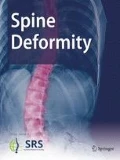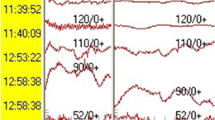Abstract
The Scoliosis Research Society has developed an updated information statement on intraoperative neurophysiological monitoring of spinal cord function during spinal deformity surgery. The statement reviews the risks of spinal cord compromise associated with spinal deformity surgery; the statement then discusses the various modalities that are available to monitor the spinal cord, including somatosensory-evoked potentials, motor-evoked potentials, and electromyographic (EMG) options. Anesthesia considerations, the importance of a thoughtful team approach to successful monitoring, and the utility of checklists are also discussed. Finally, the statement expresses the opinion that utilization of intraoperative neurophysiological spinal cord monitoring in spinal deformity surgery is the standard of care when the spinal cord is at risk.
Similar content being viewed by others
References
MacEwen GD, Bunnell WP, Sriram K (1975) Acute neurological complications in the treatment of scoliosis: a report of the Scoliosis Research Society. J Bone Jt Surg Am 57:404–408
Schmitt EW (1981) Neurological complications in the treatment of scoliosis. A sequential report of the Scoliosis Research Society 1971–1979. In: Reported at the 17th annual meeting of the Scoliosis Research Society, Denver
Wilber RG, Thompson GH, Shaffer JW et al (1984) Post-operative neurological deficits in segmental spinal instrumentation. J Bone Jt Surg Am 66:1178–1187
Burton DC, Carlson BB, Place HM et al (2016) Results of the scoliosis research society morbidity and mortality database 2009–2012: a report from the morbidity and mortality committee. Spine Deform 4:338–343
Diab M, Smith AR, Kuklo TR (2007) Neural complications in the surgical treatment of adolescent idiopathic scoliosis. Spine 32:2759–2763
Bartley CE, Yaszay B, Bastrom TP et al (2017) Perioperative and delayed major complications following surgical treatment of adolescent idiopathic scoliosis. J Bone Jt Surg Am 99:1206–1212
Boachie-Adjei O, Yagi M, Nemani VM et al (2015) Incidence and risk factors for major surgical complications in patients with complex spinal deformity: a report from an SRS GOP Site. Spine Deform 3:57–64
Nuwer M (1988) Spinal cord monitoring, Chapter 3 in evoked potential monitoring in the operating room. Raven Press, New York, pp 49–101
Drummond D, Schwartz D, Johnston D et al (2003) Neurological injury complicating surgery. In: Dewald R (ed) Spinal deformities: the comprehensive text. Thieme Medical Publishers Inc, New York, pp 615–625
Vauzelle C, Stagnara P, Jouvinroux P (1973) Functional monitoring of spinal cord activity during spinal surgery. Clin Orthop Relat Res 93:173–178
Stephen JP, Sullivan MR, Hicks RG et al (1996) Cotrel–Dubousset instrumentation in children using simultaneous motor and somatosensory evoked potential monitoring. Spine 21:2450–2457
Schwartz D, Drummond D, Schwartz J et al (1997) Neurophysiological monitoring during scoliosis surgery: a multimodality approach. Semin Spine Surg 9:97–111
Padberg AM, Bridwell KH (1999) Spinal cord monitoring: current state of the art. Orthop Clin N Am 30:407–433
Strike SA, Hassanzadeh H, Jain A et al (2017) Intraoperative neuromonitoring in pediatric and adult spine deformity surgery. Clin Spine Surg 30:E1174–E1181
Master DL, Thompson GH, Poe-Kochert C et al (2008) Spinal cord monitoring for scoliosis surgery in Rett syndrome: can these patients be accurately monitored? J Pediatr Orthop 28(3):342–346
Ferguson J, Hwang SW, Tataryn Z et al (2014) Neuromonitoring changes in pediatric spinal deformity surgery: a single-institution experience. J Neurosurg Pediatr 13:247–254
MacDonald DB, Dong C, Quatrale R et al (2019) Recommendations of the International Society of Intraoperative Neurophysiology for intraoperative somatosensory evoked potentials. Clin Neurophysiol 130(1):161–179
Brown RH, Nash CL, Berilla JA et al (1984) Cortical evoked potential monitoring: a system for intraoperative monitoring of spinal cord function. Spine 9:256–261
Dinner DS, Luders H, Lesser RP et al (1986) Intraoperative spinal somatosensory evoked potential monitoring. J Neurosurg 65:807–814
Bieber E, Tolo V, Uematsu S (1988) Spinal cord monitoring during posterior spinal instrumentation and fusion. Clin Orthop Relat Res 229:121–124
Thirumala PD, Bodily L, Tint D et al (2014) Somatosensory-evoked potential monitoring during instrumented scoliosis corrective procedures: validity revisited. Spine J 14:1572–1580
Jones SJ, Edgar MA, Ransford AO et al (1983) A system for the electrophysiological monitoring of the spinal cord during operations for scoliosis. J Bone Jt Surg Br 65:134–139
Ginsburg HH, Shetter AG, Raudzens PA (1985) Postoperative paraplegia with preserved intraoperative somatosensory evoked potentials. J Neurosurg 63:296–300
Bridwell KH, Lenke LG, Baldus C et al (1998) Major intraoperative neurologic deficits in pediatric and adult spinal deformity patients: incidence and etiology at one institution. Spine 23:324–331
Schwartz DM, Auerbach JD, Dormans JP et al (2007) Neurophysiological detection of impending spinal cord injury during scoliosis surgery. J Bone Jt Surg Am 89:2440–2449
Jones SJ, Buonamassa S, Crockard HA (2003) Two cases of quadriparesis following anterior cervical discectomy, with normal perioperative somatosensory evoked potentials. J Neurol Neurosurg Psychiatry 74:273–276
Nuwer MR, Dawson ED, Carlson LG et al (1995) Somatosensory evoked potential spinal cord monitoring reduces neurologic deficits after scoliosis surgery: results of a large multicenter survey. Electroencephalogr Clin Neurophysiol 96:6–11
Chatrian GE, Berge MS, Wirch AL (1988) Discrepancy between intraoperative SSEP’s and postoperative function. A case report. J Neurosurg 69(3):450–454
DiCindio S, Theroux M, Shah S et al (2003) Multimodality monitoring of transcranial electric motor and somatosensory evoked potentials during surgical correction of spinal deformity in patients with cerebral palsy and other neuromuscular disorders. Spine 28:1851–1856
Langeloo DD, Journee HL, Polak B et al (2001) A new application of TCE-MEP: spinal cord monitoring in patients with severe neuromuscular weakness undergoing corrective spine surgery. J Spinal Disord 14:445–448
Hilibrand A, Schwartz D, Sethuraman V et al (2004) Comparison of transcranial electric motor and somatosensory evoked potential monitoring during cervical spine surgery. J Bone Jt Surg Am 86:1248–1253
Schwartz D, Dormans JP, Drummond DS et al (2007) Transcranial electric motor evoked potential monitoring during spine surgery: is it safe? In: Presented at the 42nd annual meeting of the scoliosis research society. Edinburg, Scotland, September 6, 2007
Acharya S, Palukuri N, Gupta P et al (2017) Transcranial motor evoked potentials during spinal deformity corrections—safety, efficacy, limitations, and the role of a checklist. Front Surg 4:8
Neira VM, Ghaffari K, Bulusu S et al (2016) Diagnostic accuracy of neuromonitoring for identification of new neurologic deficits in pediatric spinal fusion surgery. Anesth Analg 123:1556–1566
MacDonald DB (2002) Safety of intraoperative transcranial electrical stimulation motor evoked potential monitoring. J Clin Neurophysiol 19:416–429
Iwasaki H, Tamaki T, Yoshida M et al (2003) Efficacy and limitations of current methods of intraoperative spinal cord monitoring. J Orthop Sci 8:635–642
Leppanen RE (2005) Intraoperative monitoring of segmental spinal nerve root function with free-run and electrically-triggered electromyography and spinal cord function with reflexes and F-responses: a position statement by the American Society of Neurophysiological Monitoring. J Clin Monit Comput 19:437–461
Tsirikos A, Duckworth A, Henderson L et al (2020) Multi-modal intra-operative spinal cord monitoring (IOM) during spinal deformity surgery: efficacy, diagnostic characteristics and algorithm development. Med Princ Pract 29(1):6–17
Lyon R, Lieberman JA, Grabovac MT et al (2004) Strategies for managing decreased motor evoked potential signals while distracting the spine during correction of scoliosis. J Neurosurg Anesthesiol 16:167–170
Pastorelli F, Di Silvestre M, Plasmati R et al (2011) The prevention of neural complications in the surgical treatment of scoliosis: the role of the neurophysiological intraoperative monitoring. Eur Spine J 20(Suppl 1):S105–S114
Polly DW Jr, Rice K et al (2016) What is the frequency of intraoperative alerts during pediatric spinal deformity surgery using current neuromonitoring methodology? A retrospective study of 218 surgical procedures. Neurodiagn J 56:17–31
Chung I, Grigorian AA (2011) EMG and evoked potentials in the operating room during spinal surgery. In: Schwartz M (ed) EMG methods for evaluating muscle and nerve function. In Tech, Rijeka, pp 325–340
Laratta JL, Ha A, Shillingford JN et al (2018) Neuromonitoring in spinal deformity surgery: a multimodality approach. Glob Spine J 8:68–77
Glassman SD, Dimar JR, Puno RM et al (1995) A prospective analysis of intraoperative electromyographic monitoring of pedicle screw placement with computed tomographic scan confirmation. Spine 20:1375–1379
Lee CH, Kim HW, Kim HR et al (2015) Can triggered electromyography thresholds assure accurate pedicle screw placements? A systematic review and meta-analysis of diagnostic test accuracy. Clin Neurophysiol 126:2019–2025
Raynor BL, Lenke LG, Kim Y et al (2002) Can triggered electromyograph thresholds predict safe thoracic pedicle screw placement? Spine 27:2030–2035
Shi YB, Binette M, Marting WH et al (2003) Electrical stimulation for intraoperative evaluation of thoracic pedicle screw placement. Spine 28:595–601
Rodriguez-Olaverri JC, Mimick NC, Merola A et al (2008) Using triggered electromyographic threshold in the intercostal muscles to evaluate the accuracy of upper thoracic pedicle screw placement (T3–T6). Spine 33:E194–197
Samdani AF, Tantorski M, Cahill PJ et al (2011) Triggered electromyography for placement of thoracic pedicle screws: is it reliable? Eur Spine J 20:869–874
Macdonald DB, Skinner S, Shils J et al (2013) Intraoperative motor evoked potential monitoring—a position statement by the American Society of Neurophysiological Montitoring. Clin Neurophysiol 124:2291–2316
Gertsch JH, Moreira JJ, Lee GR et al (2019) Practice guidelines for the supervising professional: intraoperative neurophysiological monitoring. J Clin Monit Comput 33:175
Skinner SA, Aydinlar EI, Borges LF et al (2019) Is the new ASNM intraoperative neuromonitoring supervision “guideline” a trustworthy guideline? A commentary. J Clin Monit Comput 33:185–190
Deiner S (2010) Highlights of anesthetic considerations for intraoperative neuromonitoring. Semin Cardiothorac Vasc Anesth 14:51–53
Owen JH (1999) The application of intraoperative monitoring during surgery for spinal deformity. Spine 24:2649–2662
Kim SS, Cho BC, Kim JH et al (2012) Complications of posterior vertebral resection for spinal deformity. Asian Spine J 6:257–265
Stecker MM (2012) A review of intraoperative monitoring for spinal surgery. Surg Neurol Int 3(suppl 3):S174–S187
Vitale MG, Skaggs DL, Pace GI et al (2014) Best practices in intraoperative neuromonitoring in spine deformity surgery: development of an intraoperative checklist to optimize response. Spine Deform 2:333–339
Fehlings MG, Brodke DS, Norvell DC et al (2010) The evidence for intraoperative neurophysiological monitoring in spine: does it make a difference? Spine 35(9 Suppl):S37–46
Funding
No funding was received for this work.
Author information
Authors and Affiliations
Contributions
All listed authors made substantial contributions to this information statement and were responsible for specific content areas and critical revisions. Furthermore, all listed authors have approved this document as written and agreed to be accountable for all aspects of the work. The authors did make specific types of contributions and these are noted as follows: MFH and MGV: design, acquisition, and analysis; drafted and critically revised the article; approved and agreed to be accountable to all aspects of the work. KSM and AG: acquisition and analysis; drafted the article; approved and agreed to be accountable to all aspects of the work. PON and MK: conception and design; critically revised the article; approved and agreed to be accountable to all aspects of the work.
Corresponding author
Ethics declarations
Conflict of interest
Drs. Halsey, Myung and Ghag have no conflicts of interest. Dr. Vitale reports receiving grants from the Pediatric Orthopedic Society of North America (POSNA), the Scoliosis Research Society (SRS), from the Orthopedic Research and Education Fund (OREF), and the Children’s Spine Foundation (CSF) during the writing of this review. Dr. Vitale reports receiving personal fees from Zimmer Biomet, Stryker, and NuVasive that are outside the scope of the submitted work. Dr. Newton reports receiving grants from Setting Scoliosis Straight Foundation, during the writing of this review. Dr. Newton also reports receiving grants, personal fees and/or non-financial support from DePuy Synthes Spine, the SRS, EOS imaging, Thieme Publishing, NuVasive, Electrocore, Cubist, International Pediatric Orthopedic Think Tank, Orthopediatrics, K2M, Alphatech, Mazor Robotics, that are outside the scope of the submitted work. Dr. de Kleuver reports support from Medtronic that is outside the scope of the submitted work. AOSpine Knowledge Forum Deformity: steering committee member.
Additional information
Publisher's Note
Springer Nature remains neutral with regard to jurisdictional claims in published maps and institutional affiliations.
Rights and permissions
About this article
Cite this article
Halsey, M.F., Myung, K.S., Ghag, A. et al. Neurophysiological monitoring of spinal cord function during spinal deformity surgery: 2020 SRS neuromonitoring information statement. Spine Deform 8, 591–596 (2020). https://doi.org/10.1007/s43390-020-00140-2
Received:
Accepted:
Published:
Issue Date:
DOI: https://doi.org/10.1007/s43390-020-00140-2




